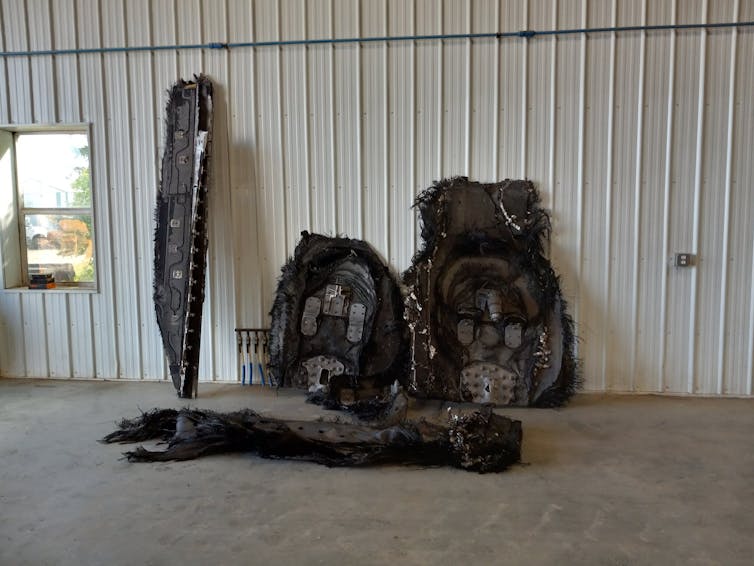
In late April, farmers in Saskatchewan stumbled upon spacecraft fragments while preparing their fields for seeding. It sounds like the beginning of a science fiction movie, but this really happened, sending a powerful warning: it is only a matter of time before someone is seriously hurt or killed by falling space junk.
The Axiom Space private astronaut mission (Ax-3) concluded safely on Feb. 9 when its SpaceX Crew Dragon capsule splashed down off the coast of Florida. Several weeks later, the Crew Dragon’s cargo trunk re-entered the atmosphere over Canada after being abandoned in orbit prior to the capsule’s return.

Several incidents
The Federal Aviation Administration, charged with approving commercial spaceflight launches in the United States, has claimed that such trunks typically “burn up” during their re-entry.
This is clearly incorrect. Similar fragments, likely from the trunk of a different Crew Dragon mission, were found in North Carolina in May, including a smaller piece that landed on the roof of a house.
Trunk fragments were even found from the first operational crewed Dragon mission (Crew-1), with those pieces strewn over fields in New South Wales, Australia. It is becoming evident that deadly debris falls to the ground every time a Crew Dragon trunk re-enters, with pieces being found whenever this occurs over an accessible area.
These are not small pieces, with some approaching the size of ping pong tables and weighing 100 pounds. They could easily cause a fatality or substantial damage.
Crew Dragon trunks are only one part of a much larger problem.

A matter of luck
Private or governmental, American or Chinese, organizations involved with space launches regularly allow objects like rocket bodies and satellites to re-enter uncontrollably, under the false premise that they will either burn up or fall into the ocean.
Indeed, NASA allowed an old battery pallet to be released from the International Space Station, knowing it would re-enter uncontrollably. NASA said it should burn up completely, which was proven wrong in March when a potentially lethal fragment crashed through the roof, then ceiling, and then floor of a house in Florida.
So far, no one is known to have been hurt by falling space junk, but that’s just a matter of luck; people are finding more and more pieces in or near inhabited areas worldwide.
Whose responsibility?
The 1972 Liability Convention makes countries absolutely liable for damage, including loss of life, caused by its space objects falling onto the surface of the Earth or striking airplanes in flight. And the 1967 Outer Space Treaty makes countries responsible for all their space actors, including private companies.
Yet the Liability Convention is an agreement between countries, which makes the interactions between private citizens — like Saskatchewan farmers — and powerful space companies — like SpaceX — less straightforward. In the absence of governmental action, individuals may need to resort to lawsuits.
As for the Crew Dragon trunk scattered across Saskatchewan, in June, SpaceX sent two employees in a rented U-Haul truck to pick up the pieces, reportedly paying farmers for the fragments. Had there been a death, or damage to million-dollar farm equipment, the outcome would have been much more complicated.
What goes up must come down
Uncontrolled re-entries are relics of early spaceflight. But with rocket launches occurring almost daily — fuelled in part by space tourism, megaconstellations and large low Earth orbit satellites — these uncontrolled re-entries cannot continue. Estimates already place the yearly chance of a casualty at a few per cent, and it will get worse.
Read more: An astronomer's lament: Satellite megaconstellations are ruining space exploration
A clear alternative is to use controlled re-entries through a combination of mission planning, restrictions on the number of re-entries, and reignitable engines; these technologies and practices already exist, albeit at extra costs.
For objects that cannot be controlled, they will need to be designed to burn up in the atmosphere entirely. But this practice is already affecting upper atmosphere chemistry, with potential implications for climate and ozone depletion.
Read more: Defunct satellites burning up in the atmosphere could damage the ozone layer. Here's how
And when corporations or governmental organizations exceed pollution and safety thresholds for re-entry, licences should be suspended or revoked until the issue is addressed.
Immediate action needed
There is no doubt that satellites and space technologies bring tremendous benefits to society. But the promise of prosperity is not an excuse for reckless behaviour.
Regulating agencies need to stop ignoring close calls — like the SpaceX debris that fell on Saskatchewan — and take action, before disaster strikes.
Aaron Boley receives funding from the Natural Sciences and Engineering Research Council of Canada and the New Frontiers in Research Fund. He is the co-director of the Outer Space Institute.
Samantha Lawler receives funding from the Natural Sciences and Engineering Research Council of Canada. She is a fellow of the Outer Space Institute.
This article was originally published on The Conversation. Read the original article.




!["[T]he First and Fifth Amendments Require ICE to Provide Information About the Whereabouts of a Detained Person"](https://images.inkl.com/s3/publisher/cover/212/reason-cover.png?w=600)


